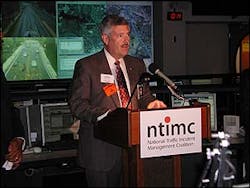GAITHERSBURG, MD -- As Americans hit the road this holiday weekend, they are being asked to be extremely cautious if they encounter a crash.
To insure the safety of everyone from first responders to police officers and tow truck operators, drivers are encouraged to slow down and move over.
That was the message delivered Tuesday morning as federal, state and local officials launched the National Unified Goal for Traffic Incident Management (NUG).
Increasing the public's awareness for safety on the nation's highways has to be a unified effort, said J. Richard Capka, Federal Highway Administrator.
Capka said agencies need to use technology to address the challenges of traffic congestion. "Safety is a huge problem for us," he said, adding that the highway is a very unsafe place for responders.
The National Traffic Incident Management Coalition (NTIMC) -- comprised of various stakeholders -- has been addressing various issues for several years, and developed NUG.
The major objectives include responder safety; safe, quick clearance (of debris and vehicles from the highway) and prompt, reliable, interoperable communications between agencies.
NTIMC members included representatives of national fire and EMS agencies, tow truck operators, highway officials, engineers, communications, and truck drivers.
The executive director of the International Association of Fire Chiefs (IAFC) said firefighters have had "a long history dealing with safety."
Mark W. Light said it's essential that all disciplines work together to achieve the goal.
Light said of the 248 vehicle incidents reported to the National Firefighter Near-Miss Program, more than 10 percent involved close calls on the highway.
"The NUG will provide a valuable tool to help improve responder safety," he said.
The IAFC head also said it's important that Congress understand the importance of funding for better data collection.
Paramedic Kevin McGinnis said a highway crash takes a toll on everyone including the motorists involved.
"It's also scary for us as well," he said, adding that responders often get so busy with their work that traffic control is overlooked.
McGinnis, program advisor for the National Association of EMS Officials, said he was impressed with the cooperation of the coalition that has worked diligently on the project.
Officials understand they have their work cut out for them. First, they have to get the public onboard with what's expected of them when they come across a highway incident. And, they also have to strengthen the partnerships of all those who respond to those occurrences.
Steve Austin, an official with the Emergency Responder Safety Institute, said the bottom goal is to keep everyone safe.
"Today was a good day for first responders and the motoring public. This is a cooperative effort. We're in this together -- to keep people safe while they work on the highways and to do what we can do to reduce traffic congestion."
Austin said NTIMC members have been made more aware of each other's responsibilities. "This is a partnership. We all know what must be done."
Several states have laws requiring motorists to slow down and vacate the lane closest to the first responder, police officer or tow truck.
The effort also is important to the Towing and Recovery Association of America. Every year, several operators are struck as they perform their jobs, said Mike Scott, chairman of the group's education foundation.
"We join with other traffic incident responders in asking that you slow down," he said.
Likewise, AAA also is committed to the effort.
Yolanda Clark said it will take a cooperative and coordinated effort to keep the highways safe.
While NUG is not mandatory, the coalition hopes it will open lines of communication between agencies that deal with incidents on the highways. "(It) will encourage state and local transportation and public safety agencies to adopt unified, multi-disciplinary policies, procedures and practices that will dramatically improve the way traffic incidents are managed on U.S. roadways," the document reads.
Light said incidents run smoother and safer when the people responsible have a strong relationship.
For additional information:






